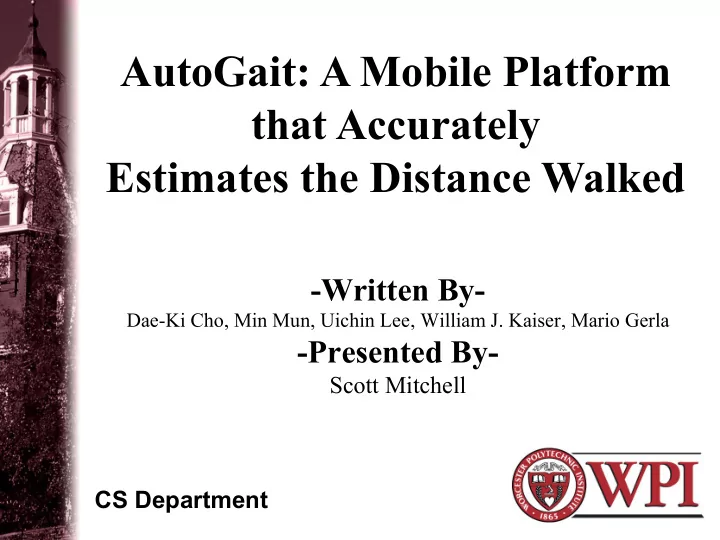

AutoGait: A Mobile Platform that Accurately Estimates the Distance Walked -Written By- Dae-Ki Cho, Min Mun, Uichin Lee, William J. Kaiser, Mario Gerla -Presented By- Scott Mitchell CS Department
Problem Domain • Accurately determine distance walked • Critical for indoor navigation systems, pedometers... • Dynamic changes in stride length and step frequency 2 Worcester Polytechnic Institute
“Traditional” Estimation • Indoor – RF-based fingerprinting (WiFi/GSM/Bluetooth) – Dead Reckoning (accelerometer or pressure sensing pedometer) • Outdoor – GPS tracking • Distance = # steps * average stride 3 length Worcester Polytechnic Institute
Alternative Approach • Traditional methods do not account for changes in stride length of frequency of steps taken • Traditional approaches may require manual calibration per user • Linear relationship between stride length and step frequency – Applies indoors, outdoors, and regardless of age/gender 4 Worcester Polytechnic Institute
Location Tracking Technique ● GPS Location Tracking – Noisy (error ~ 5m-10m) • Break path into line segments – Change in heading used – Compute stride length / step frequency for each segment using walking profile • Auto calibration for walking profile 5 Worcester Polytechnic Institute
Architecture ● GPS data filter/calibration ● COTS ● Smoothing ● Pedometer ● Step history ● Distance walked 6 Worcester Polytechnic Institute
Measurement Approach • Stride Length Lookup (SSL) – S = a freq + B • Segmentation – Immobility Detection (> sum of mean and three times std deviation) – Unrealistic Movement Detection (speed between two points > sum of average and two time std deviation) • Smoothing – Convolution with uniform distribution • Straight Line Identification – Consider near straight-line walking patterns over noisy GPS 7 Worcester Polytechnic Institute
Questions / Comments • End of over view • More details coming up...wake up 8 Worcester Polytechnic Institute
Straight Line Detection Heading change vectors: Cumulative heading changes: 9 Worcester Polytechnic Institute
Straight Line Detection Cont. • Obtain maximum i such that e i < ET and e j (1<=j<i) • If GPS coordinates P 1 ,..P i+2 are within boundary, where i is sufficiently large, it is assumed a straight-line segment. • The process repeats to extract more straight line segments. Heading values are excluded from the summation heading summation (i to h) if needed. 10 Worcester Polytechnic Institute
Walking Profile Calibration • End-to-End: D i+1 Distance between two endpoints of the segment • Update SLL using • Sum Up: i + 1 ∑ j = 1 d j linear least squares cumulative distance fitting with existing of two consecutive samples to obtain points in the new alpha and beta segment coefficients • Average Stride Length = distance / (# edges in segment * # 11 steps in an edge) Worcester Polytechnic Institute
Calibration Termination • Continuous calibration until least squares method converges – After sufficient samples obtained – GPS is turned off to conserve energy • Angle of change between slope of new equation (a i ) and previous slope (a i-1 ) is smaller than gamma for m calibration samples 12 Worcester Polytechnic Institute
AutoGait Prototype • Nokia N810, Linux, Python • Custom pedometer using low force sensors – SmartShoe platform to avoid low acceleration motion sensing problems – Bluetooth connection to N810, sepearte threads for gathering data and counting steps • GPS reading acquired every 10 steps 13 Worcester Polytechnic Institute
Results • Calibrated by walking around campus • Track testing (sum up wins) with Treadmill verification (end- to-end) 14 Worcester Polytechnic Institute
Questions / Comments • Change in altitude? • Running vs Walking? • Typical battery life? • Claimed to be useful for indoors, but how do you read GPS indoors? – Mentioned compasses, but how reliable are they in your pocket? 15 Worcester Polytechnic Institute
Recommend
More recommend